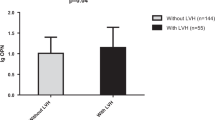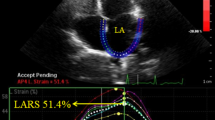Abstract
Objectives
Previous studies showed that subclinical abnormal left atrial (LA) function could be diagnosed with LA speckle tracking evaluation long before chamber enlargement. Osteoprotegerin (OPG) is a member of the tumor necrosis factor (TNF) receptor superfamily and was recently found to be an indicator for adverse cardiovascular outcomes and a risk factor for new onset atrial fibrillation. The authors hypothesized that OPG values could predict LA mechanical dysfunction and LA remodeling assessed by two-dimensional speckle tracking echocardiography (2D-STE) in patients with hypertension (HT) and diabetes mellitus (DM).
Methods
A single center study was conducted including consecutive patients presenting to the authors’ outpatient clinic. Enrolled patients needed to have been treated for HT and DM for at least 1 year.
Results
The study included 80 patients (mean age, 57.5 ± 8.3 years). Patients in the impaired LA strain group were older (p = 0.035), had lower low density lipoprotein (LDL) cholesterol (mg/dl) (p = 0.021), and higher OPG (pmol/l) (p = 0.004) values than patients in the normal LA strain group. Univariate logistic regression analysis demonstrated that age (p = 0.039), LDL cholesterol (mg/dl) (p = 0.025), and OPG (pmol/l) (p = 0.008) values were associated with impaired LA strain. Backward multivariate logistic regression analysis showed that LDL cholesterol (mg/dl) (OR: 0.982, CI 95% 0.964–0.999, p = 0.049) and OPG (pmol/l) (OR: 1.438, CI 95% 1.043–1.983, p = 0.027) were independently associated with impaired LA strain.
Conclusion
In hypertensive and diabetic patients, higher OPG values were associated with impaired LA function assessed by 2D-STE. In this high-risk patient group, serum OPG can be used as a risk predictor for LA mechanical dysfunction.
Zusammenfassung
Zielsetzung
Frühere Studien belegen, dass eine subklinisch gestörte linksatriale (LA) Funktion mithilfe der linksatrialen Speckle-tracking-Analyse lange vor einer Kammervergrößerung diagnostiziert werden kann. Osteoprotegerin (OPG) gehört zur Familie der Tumor-Nekrose-Faktor(TNF)-Rezeptor-Superfamilie und wurde vor Kurzem als Indikator eines ungünstigen kardiovaskulären Verlaufs und als Risikofaktor für neu auftretendes Vorhofflimmern identifiziert. Es wird postuliert, dass die OPG-Werte bei Patienten mit Hypertonie (HT) und Diabetes mellitus (DM) ein Prädiktor für mechanische LA-Dysfunktion und LA-Remodeling in der zweidimensionalen Speckle-tracking-Echokardiographie (2D-STE) sind.
Methoden
In eine Single-Center-Studie wurden konsekutiv Patienten eingeschlossen, die sich in der Klinik der Autoren ambulant vorstellten. Voraussetzung für den Einschluss war eine mindestens 1‑jährige Behandlung wegen HT und DM.
Ergebnisse
Insgesamt 80 Patienten wurden in die Studie eingeschlossen (Durchschnittsalter 57,5 ± 8,3 Jahre). Die Patienten in der Gruppe mit gestörtem LA-Strain waren älter (p = 0,035), hatten einen niedrigeren Low-density-Lipoprotein(LDL)-Cholesterin-Spiegel (mg/dl; p = 0,021) und höhere OPG-Spiegel (pmol/l; p = 0,004) als Patienten in der Gruppe mit normalem LA-Strain. Eine univariate logistische Regressionsanalyse ergab, dass das Alter (p = 0,039), LDL-Cholesterin (mg/dl; p = 0,025) und OPG (pmol/l; p = 0,008) mit einem gestörten LA-Strain assoziiert waren. In einer rückwärts gerichteten multivariaten logistischen Regressionsanalyse waren LDL-Cholesterin (mg/dl; OR 0,982, 95%-Konfidenzintervall [KI] 0,964–0,999, p = 0,049) und OPG (pmol/l; OR 1,438, 95%-KI 1,043–1,983, p = 0,027) unabhängig mit einem gestörten LA-Strain assoziiert.
Schlussfolgerung
Bei Patienten mit Hypertonie und Diabetes waren höhere OPG-Werte mit einer gestörten LA-Funktion in der 2D-STE assoziiert. In dieser Hochrisikogruppe kann der Serum-OPG-Spiegel als Risikoprädiktor der mechanischen LA-Dysfunktion genutzt werden.





Similar content being viewed by others
References
Verdecchia P, Angeli F, Reboldi G (2018) Hypertension and atrial fibrillation: doubts and certainties from basic and clinical studies. Circ Res 122(2):352–368
Wang A et al (2019) Atrial fibrillation and diabetes mellitus: JACC review topic of the week. J Am Coll Cardiol 74(8):1107–1115
Mondillo S et al (2011) Early detection of left atrial strain abnormalities by speckle tracking in hypertensive and diabetic patients with normal left atrial size. J Am Soc Echocardiogr 24(8):898–908
Vianna-Pinton R et al (2009) Two-dimensional speckle-tracking echocardiography of the left atrium: feasibility and regional contraction and relaxation differences in normal subjects. J Am Soc Echocardiogr 22(3):299–305
Simonet WS et al (1997) Osteoprotegerin: a novel secreted protein involved in the regulation of bone density. Cell 89(2):309–319
Ueland T et al (2005) Dysregulated osteoprotegerin/RANK ligand/RANK axis in clinical and experimental heart failure. Circulation 111(19):2461–2468
Reinhard H (2010) Osteoprotegerin and mortality in type 2 diabetic patients. Diabetes Care 33(12):2561–2566
Blazquez-Medela AM et al (2012) Osteoprotegerin is associated with cardiovascular risk in hypertension and/or diabetes. Eur J Clin Invest 42(5):548–556
Liu W, Zhang X (2015) Receptor activator of nuclear factor-kappaB ligand (RANKL)/RANK/osteoprotegerin system in bone and other tissues (review). Mol Med Rep 11(5):3212–3218
Imai E et al (2007) Modification of the modification of diet in renal disease (MDRD) study equation for Japan. Am J Kidney Dis 50(6):927–937
Nagueh SF et al (2016) Recommendations for the evaluation of left ventricular diastolic function by echocardiography: an update from the American Society of Echocardiography and the European Association of Cardiovascular Imaging. J Am Soc Echocardiogr 29(4):277–314
Lang RM et al (2015) Recommendations for cardiac chamber quantification by echocardiography in adults: an update from the American Society of Echocardiography and the European Association of Cardiovascular Imaging. J Am Soc Echocardiogr 28(1):1–39e14
Badano LP et al (2018) Industry representatives; reviewers: this document was reviewed by members of the 2016–2018 EACVI scientific documents committee. Standardization of left atrial, right ventricular, and right atrial deformation imaging using two-dimensional speckle tracking echocardiography: a consensus document of the EACVI/ASE/industrytask force to standardize deformation imaging. Eur Heart J Cardiovasc Imaging 19(6):591–560
Pathan F et al (2017) Normal ranges of left atrial strain by speckle-tracking echocardiography: a systematic review and meta-analysis. J Am Soc Echocardiogr 30(1):59–70
Thomas L, Abhayaratna WP (2017) Left atrial reverse remodeling: mechanisms, evaluation, and clinical significance. JACC Cardiovasc Imaging 10(1):65–77
Nattel S (2017) Molecular and cellular mechanisms of atrial fibrosis in atrial fibrillation. JACC Clin Electrophysiol 3(5):425–435
Koyama S et al (2014) Osteoprotegerin is secreted into the coronary circulation: a possible association with the renin-angiotensin system and cardiac hypertrophy. Horm Metab Res 46(8):581–586
Cao H et al (2014) Serum sRANKL/OPG predict recurrence after radiofrequency catheter ablation of lone atrial fibrillation. Int J Cardiol 170(3):298–302
Xi L et al (2013) OPG/RANK/RANKL axis in stabilization of spontaneously restored sinus rhythm in permanent atrial fibrillation patients after mitral valve surgery. Cardiology 124(1):18–24
Schnabel RB et al (2009) Relation of multiple inflammatory biomarkers to incident atrial fibrillation. Am J Cardiol 104(1):92–96
Cao Y et al (2019) Plasma osteoprotegerin correlates with stroke severity and the occurrence of microembolic signals in patients with acute ischemic stroke. Dis Markers 2019:3090364
Songia P et al (2016) Mitral valve endothelial cells secrete osteoprotegerin during endothelial mesenchymal transition. J Mol Cell Cardiol 98:48–57
Kawakami H et al (2019) Left atrial mechanical dispersion assessed by strain echocardiography as an independent predictor of new-onset atrial fibrillation: a case-control study. J Am Soc Echocardiogr 32(10):1268–1276e3
Rosca M et al (2011) Left atrial function: pathophysiology, echocardiographic assessment, and clinical applications. Heart 97(23):1982–1989
Çetin M et al (2020) Endothelial dysfunction, subclinical atherosclerosis andLDL cholesterol are the independent predictors of left atrial functions inhypertension. Int J Cardiovasc Imaging 36(1):69–77
Li ZZ et al (2018) Association between blood lipid profiles and atrial fibrillation: a case–control study. Med Sci Monit 24:3903–3908
Author information
Authors and Affiliations
Corresponding author
Ethics declarations
Conflict of interest
E. Kalaycıoğlu, M. Çetin, G. Çinier, T. Kırış, T. Gökdeniz, A.G. Özyıldız, and İ. Durmuş declare that they have no competing interests.
All procedures performed in studies involving human participants or on human tissue were in accordance with the ethical standards of the institutional and/or national research committee and with the 1975 Helsinki declaration and its later amendments or comparable ethical standards. Informed consent was obtained from all individual participants included in the study.
Rights and permissions
About this article
Cite this article
Kalaycıoğlu, E., Çetin, M., Çinier, G. et al. Serum osteoprotegerin level is independently related to subclinical left atrial mechanical function in patients with hypertension and diabetes. Herz 46, 277–284 (2021). https://doi.org/10.1007/s00059-020-04939-7
Received:
Revised:
Accepted:
Published:
Issue Date:
DOI: https://doi.org/10.1007/s00059-020-04939-7
Keywords
- Atrial fibrillation
- Cholesterol, LDL
- Vascular system
- Left atrium
- Two-dimensional speckle tracking echocardiography




